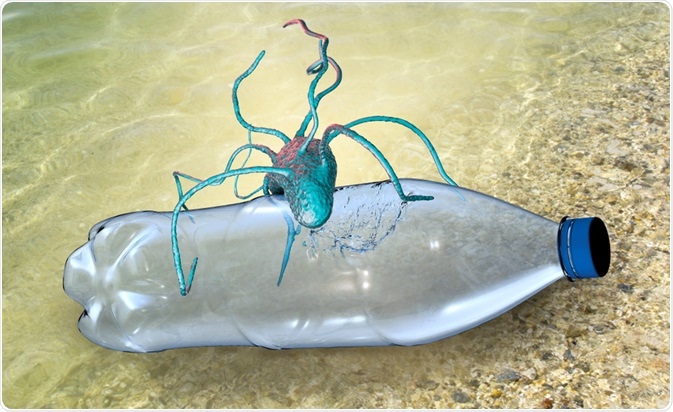A study published by the Society for Applied Microbiology in their journal Environmental Microbiology Reports has outlined how the main constituents of plastics can be degraded by anaerobic and aerobic microorganisms. This form of microorganism-based strategy for plastic waste management represents a novel, sustainable means of eliminating plastics from the environment.
 Image Credits: Kateryna Kon / Shutterstock.com
Image Credits: Kateryna Kon / Shutterstock.com
The authors of the minireview outline how the major constituent compounds of plastics - which encompass the organic compounds phthalic acid (PA), isophthalic acid (IPA) and terephthalic acid (TPA) - can be subject to biodegradation. Moreover, the group impresses on the environmental importance of anaerobic biodegradation as a viable, scalable means to do so.
The three isomers: major components of plasticizers and polymers
Phthalic acids are the essential components of plastics. These synthetic organic polymers offer a cheap means of packaging production and their demand is expected to see the worldwide annual production of plastics double to 600 million tons within 20 years. Despite this, they are responsible for environmental problems and health concerns worldwide.
Plastic waste occupies landfills and oceans where they endanger the local wildlife and disrupt ecosystems. Although recycling represents one option for limiting new plastic production, this material is primarily incorporated into secondary products which offer a reduced quality of the material property. Moreover, recycling does not prevent the entry of microplastic pollutants in marine ecosystems.
These on-going challenges have motivated the development of organic-led approached to plastic waste management including biodegradation.
Degradation pathways
The anaerobic and aerobic degradation of PA, IPA, and TPA differ substantially in microorganisms. Aerobic microorganisms introduce a hydroxyl functionality via dioxygenases. This increases the likelihood of subsequent decarboxylation via aromatizing dehydrogenases or cofactor‐free decarboxylases.
Anaerobic bacteria, however, employ CoA ligases or CoA transferases to activate the PA isomers; these are then decarboxylated by decarboxylases to produce benzoyl-CoA. These decarboxylases fall under the UbiD enzyme family and are characterized by a prenylated flavin mononucleotide (FMN) cofactor.
This cofactor is essential for the mechanistic success of decarboxylation. A core challenge of decarboxylation is the capture of the highly unstable A‐CoA intermediate, which is mitigated by the overproduction of phthaloyl‐CoA decarboxylase.
Phthalic acid biodegradation
PA forms the building blocks for plastic polymers. They are linked by ester bonds that require excess hydration before hydrolytic enzymes can access the bonds for cleavage. The water‐resistant nature of plastics makes this difficult. Coupled with the large energy expenditure associated with the production and secretion of these enzymes by bacteria, the breakdown of plastic is non-viable; the metabolic energy released from the products does not expense the energy of breakdown.
Enzymes and metabolites involved in anaerobic PA degradation
The uptake of PA is achieved by a periplasmic binding protein and TRAP transporter. Once in the cell, succinyl‐CoA: phthalate CoA transferase (SPT) converts PA to the unstable phthaloyl‐CoA. The second step in anaerobic PA degradation is its decarboxylation, catalyzed by phthaloyl‐CoA decarboxylase (PCD). This belongs to the UbiD family.
The highly labile phthaloyl‐CoA represents a challenge of anaerobic PA degradation; because of this, the formation of an SPT and PCD complex was believed to occur. However, the estimated cellular concentration of PCD was found to be 250‐fold higher than its substrate phthaloyl‐CoA. This ensures that phthaloyl-CoA is efficiently captured and decarboxylated. Degradation via this intermediate represents a poorly optimized xenobiotic degradation pathway
The evolution of PA degradation pathways
The degradation pathways typically employed by bacteria include hydrolysis to the individual PA isomers and alcohols. This is followed by decarboxylation of either of the two carboxylic acid entities. This step is mechanistically difficult to achieve owing to the high energy intermediates formed as a result of the negatively charged group. As such, activation of PA is preferred.
To circumvent the issue, the existing body of research has seen the development of two aerobic and one anaerobic strategies to accomplish decarboxylation. This includes:
- The introduction of hydroxyl groups directly at a carboxyl group of IPA and TPA by a dioxygenase under aerobic conditions. This produces cis‐diol‐dienes that can be decarboxylated
- Aerobic PA degradation proceeds via dihydroxyphthalate intermediates which increases the likelihood of successful decarboxylation due to the positioning of the carboxyl groups
- PA, IPA and TPA then processed via thioesterification (production of a reactive thioester) followed by decarboxylation by UbiD‐like decarboxylases
How this activation results in decarboxylation remains to be determined; there are currently ongoing efforts to elucidate the structure of the UbiD‐like decarboxylases implemented in the degradation of all three PA isomers. It is believed that the mechanism of the phthaloyl‐CoA and terephthaloyl‐CoA decarboxylases should be similar but separate from the sophthaloyl‐CoA decarboxylase.
Phthaloyl‐CoA: A highly unstable intermediate
The phthaloyl‐CoA intermediate is a poor thioester as it undergoes cycles of futile hydrolysis. As a result, anaerobic phthalate degradation via phthaloyl‐CoA is wasteful. While PA is known as an intermediate of aerobic degradation, it does not feature in the anaerobic pathway. This places the anaerobic solution as a viable means for the degradation of plastics.
The team hopes that the evolution of the anaerobic pathway will result in the formation of a complex between Succinyl‐CoA: phthalate CoA transferase (SPT) and phthaloyl‐CoA decarboxylase (PCD). This will enable direct transfer of phthaloyl‐CoA between the active sites, eliminating the lability of the intermediate. This strategy has been observed for similarly highly reactive intermediates elsewhere in the environment.
Source
Boll, M et al. (2020) Microbial degradation of phthalates: biochemistry and environmental implications. Environmental Microbiology Reports doi: 10.1111/1758-2229.12787